On this weeks NewsFlash, we discover the caterpillar that tricks it's ant hosts into treating it like royalty, find out why fish get lost in acidic seas and why the gravitational pull of tonnes of ice may lead to greater sea level rise than predicted. Plus, we explore the oldest evidence of complex life - a chemical signature in rocks up to 750 million years old.
In this episode
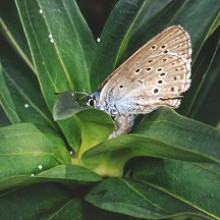
Caterpillars kings of the mimics
Scientists from Oxford and Turin have found that certain species of caterpillars have developed the ability to use sounds to fool ants into accepting and nurturing them.
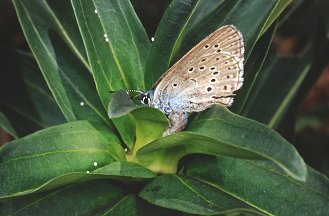 Writing in this week's Science Francesca Barbero and her colleagues describe how they used sensitive microphones to eavesdrop on Myrmica schencki ants, the nests of which are invaded by caterpillars of the rare blue butterfly Maculinea rebeli. Somehow these caterpillars persuade the ants not just to accept them but also to treat them like royalty, even feeding their own young to the hungry butterfly larvae if food runs short.
Writing in this week's Science Francesca Barbero and her colleagues describe how they used sensitive microphones to eavesdrop on Myrmica schencki ants, the nests of which are invaded by caterpillars of the rare blue butterfly Maculinea rebeli. Somehow these caterpillars persuade the ants not just to accept them but also to treat them like royalty, even feeding their own young to the hungry butterfly larvae if food runs short.
Scientists have known for some time that chemicals come into play and that the caterpillars secrete odour molecules that make them smell like an ant, but that couldn't be the whole story because it wouldn't explain why the larvae receive such preferential treatment in the nest. This prompted the Oxford and Italian team to wonder whether the caterpillars might also be resorting to a form of sonic subterfuge to elevate their status because the ants communicate with one another through rasping sounds produced by rubbing together the rough surfaces of parts of their abdomens.
Queen ants produce subtly different sounds to workers, and recordings from the caterpillars in the nests show that they are mimicking the noises of ant queens.
| Myrmica schencki - Queen Ant |
| Maculinea rebeli - Caterpillar |
"This is the first time anyone has been able to record like this, with insects in their native environment and that are not distressed. This is why we picked this up," explains co-author Jeremy Thomas. "This is a wonderful example of evolution. This blue butterfly group has a long history of a co-existence with this ant species. Over time the caterpillars have adapted to exploit the ants by mimicking their signals, allowing the caterpillar to penetrate the nest where the ants protect and feed it."
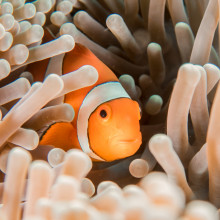
Nemo could get lost in acidic ocean
If you've seen the movie Finding Nemo, then you'll know that Nemo the clown fish got lost and had to try and find his way back to his home reef.
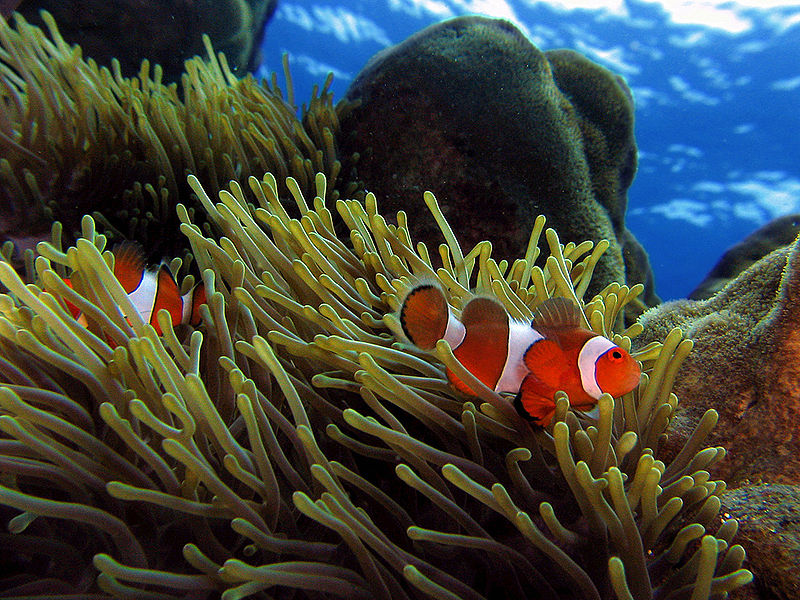 Now it seems that the Disney animators may have been onto something, because a study published in the journal PNAS led by Philip Munday from James Cook University in Queensland, Australia, found that clown fish may indeed get lost if the oceans become more acidic. And that is likely to happen as more carbon dioxide enters the atmosphere and dissolves in the seas forming carbonic acid.
Now it seems that the Disney animators may have been onto something, because a study published in the journal PNAS led by Philip Munday from James Cook University in Queensland, Australia, found that clown fish may indeed get lost if the oceans become more acidic. And that is likely to happen as more carbon dioxide enters the atmosphere and dissolves in the seas forming carbonic acid.
Many coral reef fish spend the first few weeks of life as tiny larvae drifting through the open ocean. And previous studies have shown that they follow their noses and their ears, sniffing out and listening to sounds that lead them back to the reefs they were born on.
But, it seems that as the acidity of seawater increases, fish may loose their sense of smell and have trouble finding their way home.
Munday and his team took newly-hatched clown fish larvae and put them in choice chambers in the laboratory filled with water containing different chemicals. In seawater of normal acidity, the clownfish preferred to swim in the plume of water that smelt of rainforest trees, because in the wild they live on reefs that surround vegetated islands.
When the acidity was increased, the clown fish instead choose to swim in the plume of water that smelled of swamps, a smell they hate and usually avoid.
It may not sound like much of a difference - swamps or rainforest trees - but if wild fish start to loose their ability to find the right sort of habitat, it could spell disaster for entire populations and ecosystems.
So this study spells out yet more gloomy forecasts for the changes that might take place as carbon dioxide continues to build up in the atmosphere and even more reason to try and find ways of curbing our emissions of the greenhouse gas.
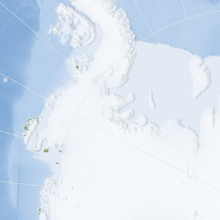
Gravity may make sea level rise worse
Gravity might have a major role to play in future sea-level rise, scientists are predicting.
If the world is going to warm up then this is going to cause the sea level to rise.
As water warms up it expands so it takes up more space and as ice on the continents melts it dumps more water into the oceans. Many models predict the melting of the west antarctic ice sheet which is predicted to produce a 5m rise in sea level, but researchers from the university of Toronto have noticed that these models haven't taken something important into account: gravity.
Everything with mass attracts everything else with mass gravitationally. So the 22 million billion tonnes of ice in the Antarctic ice sheet are attracting the sea water around them.
This lifts the local sea level creating a bulge around the ice sheet. So when the ice sheet melts you not only get a redistribution of the water in the sheetbut around it too.
Also, moving thousands of cubic kilometres of water could cause the Earth's axis to move by as much as five hundred metres, which will move where the centrifugal bulge of the earth is acting, changing the shape of the Earth and the oceans above it.
The overall effect of all this is that the sea level aroung North America and the Southern Indian Ocean could rise by an extra 1.5m on top of the 5m already predicted. The sea around West Antarctica could only rise 4m instead of 5.
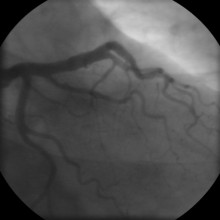
A new urine test for heart disease
This week researchers have reported a new way of diagnosing whether someone is likely to develop coronary artery disease or CAD by testing the chemicals present in their urine.
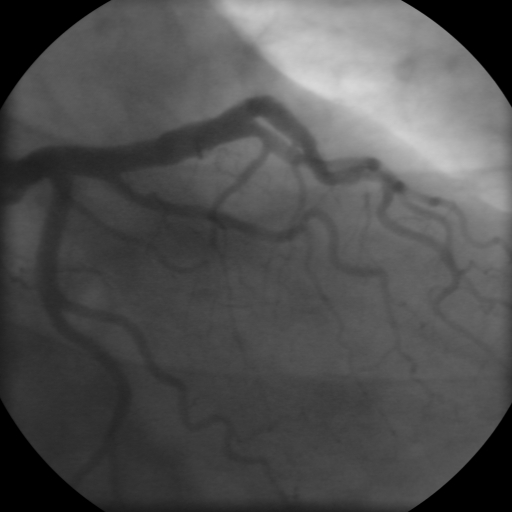 CAD is a major cause of death around the world and currently the only way to diagnose it is to conduct an angiogram, which is expensive and invasive involving injecting dye into the blood that shows up on x-rays and allows doctors to see how badly blood vessels are getting lined by fatty deposits or plaque, that can restrict and eventually block the flow of blood to the heart causing a heart attack.
CAD is a major cause of death around the world and currently the only way to diagnose it is to conduct an angiogram, which is expensive and invasive involving injecting dye into the blood that shows up on x-rays and allows doctors to see how badly blood vessels are getting lined by fatty deposits or plaque, that can restrict and eventually block the flow of blood to the heart causing a heart attack.
Now a team of researchers led by Karlheinze Peter from the Baker Heart Research Institute in Melbourne, Australia have identified 17 specific peptides (the molecules that make up proteins) in the urine of people who were diagnosed as having CAD using angiograms.
Their study published in the Journal of proteome research describes also describes how Peter and his team carried out a blind test on these peptides. By first screening the urine of a group of volunteers, then subsequently giving them angiograms it was shown that the urine test accurately picked out the people with CAD around 84% of the time.
They also found a direct link between these peptides and CAD, because they found these same chemicals in the fatty plaques that line the blood vessels of people with the condition, which is presumably why these peptides are finding their way via the blood stream into the urine.
It is still early days for a new CAD urine test to be rolled out, but these findings point the way towards a cheap, non-invasive test, that one day may hopefully help to detect the condition much earlier, giving patients a chance to make changes to their diet and lifestyle to help control the development of the disease.
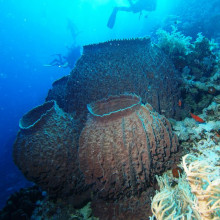
13:24 - Finding the Oldest Evidence of Life
Finding the Oldest Evidence of Life
Dr Gordon Love, University of California at Riverside
Chris - Researchers have found evidence of the earliest animal life on Earth. It shows that complex life was actually flourishing here much earlier in the Earth's history than we previously thought. Dr Gordon Love who's at the University of California at Riverside has covered the chemical fingerprints of sponges which are thought to be the first forms of animal life. He found it in rocks that are up to 750-odd million years old. Hello, Gordon. Welcome to the Naked Scientists. What have you actually done?
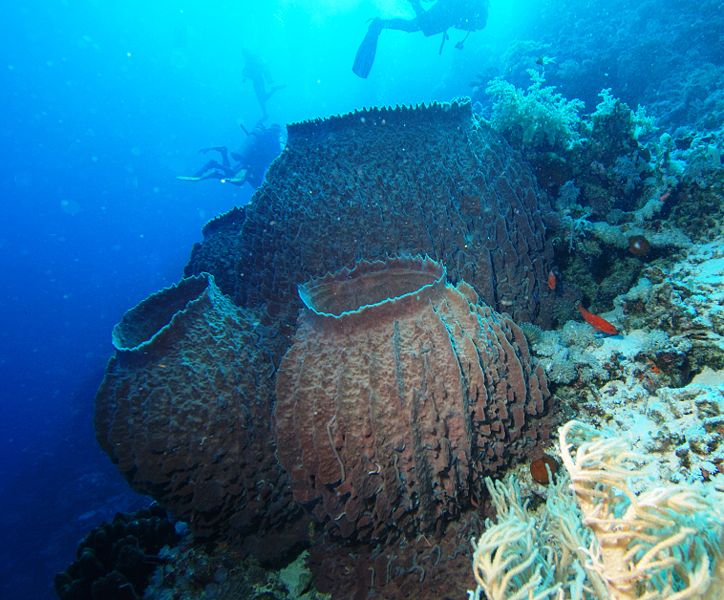 Gordon - What we did was we looked through rocks in a certain line and we have a continuous sequence of rocks and an opportunity for looking at the geobiology of this time. We found a continuous 100 million year record of sponges, going from a time known as the Cryogenian which is the time associated with two immediate glacial episodes and extending right up into the early Cambrian period.
Gordon - What we did was we looked through rocks in a certain line and we have a continuous sequence of rocks and an opportunity for looking at the geobiology of this time. We found a continuous 100 million year record of sponges, going from a time known as the Cryogenian which is the time associated with two immediate glacial episodes and extending right up into the early Cambrian period.
Chris - Where did you get these rocks from? How did you find them?
Gordon - We were fortunate we were working with an oil company in Oman, Petroleum Development in Oman. They're just currently in an area of the world where people are producing vast amounts of oil from rocks of this age. Through our contacts in the oil company we had access to very pristine material from drill cores. That became very important in having this stretch of time and also the fact that these were very thermally well-preserved rocks that we were dealing with.
Chris - If you're looking at the fossil record though, and this frustrated Charles Darwin, life appears to pop into existence about 540 million years ago because prior to then presumably there weren't enough animals with hard body parts that could be fossilised. You've presumably run into the same problem. How do you know you've got sponges going back 750 million years?
Gordon - These are one of a number of steroid structures that we detected. The precursor to these molecules, the sterols are very specific to a class of sponge called demosponges. Sponges make a wide range of really unusual natural products which really interest the medical field as well. But in this case despite about four decades of research precursors have never cropped up. These precursors have never cropped up in single-celled organisms.
Chris - So what you're saying is you've now been able to unlock from the rocks chemical finger prints, if you like; molecules made by those early sponges 750 million years ago that when the animals died were locked away in those rocks. Although the animals, the vestiges of them, physically are gone their chemical legacy lives on and that is what you can detect.
Gordon - Yes, I think that's right. This is an important factor that Darwin was puzzled about. The lack of information is that if you look at smaller and smaller scale then there is a tangible record for animals significantly pre-dating the Cambrian explosion.
Chris - Just tell us a bit about the technique to get these molecules out of the rocks. You get your rock sequence from the oil driller. How do you then get out of the rocks the chemicals from the sponges? How do you know which rocks they've come from and that they were actually made by the early sponges all that time ago?
Gordon - We've a couple of approaches. The conventional way in organic geochemistry is to powder the rock after you've cleaned or removed the outer parts. Do some sort of solvent extraction technique, concentrated up the steroid components in the fraction and analyse these by gas chromatography/mass spectrometry. We found a really abundant amount of these steroids and in all the different rock formations that we looked at. To confirm that we were actually, it wasn't just coming from migrated oils that reside in the younger part of the section, what we did was we isolated what is an organic polymer. The bulk of sedimentary organic matter is actually insoluble and it can't migrate anywhere and they make up a large macromolecule. We basically broke chemical bonds by using a technique where we heat up samples with high hydrogen gas pressure. When we looked again at the steroid composition we saw that again these sterols were abundant products. In that way we could more confidently equate the age of the markers with the age of the rocks with uranium-lead isotope dating.
Chris - So this shows you that those rocks of that age had complex animals like sponges living in them. Why do you think that they're there? What does this tell us about the origin of animal life around on Earth at that time?
Gordon - Yes, most of the rock is in a depositional environment that we're looking at is shallow, marine waters. I think originally the simplest animals like sponges would have colonised the sea floor on a shallow continental shelf. It could have been tens of millions of years later we thought they could pervade into deeper water environments. I think it's telling us that at this time in terms of the environment there was finite levels of dissolved oxygen near the sea floor - at least on the shallowest water environments.
Chris - Does it fit with what we understand was happening elsewhere on earth at the time? Usually when you see an explosion of some evolutionary process there's something going on in the climate or in the Earth's other processes. Can you marry this observation with anything else going on at the same time that might explain what you're seeing?
Gordon - Yeah, now we've pushed this back, the first appearance, into the time frame of two vast glaciation events. My feeling on this is I go to many rocks of age which are older than the first glacial event and I have never seen any convincing evidence for sponge biomarkers. I think that these major glacial events radically altered ocean chemistry in the aftermath by shutting down a lot of obscure interaction. It seems, although we're still trying to get a handle on how exactly the chemical composition changed it seems they opened up avenues for new niches, especially for new organisms which could filter feed on the sea floor.
Related Content
- Previous Wearable Robots
- Next Stripping Down your Questions










Comments
Add a comment